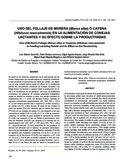| dc.rights.license | http://creativecommons.org/licenses/by-nc-sa/3.0/ve/ | |
| dc.contributor.author | Canul-Ku, Luis Alberto | |
| dc.contributor.author | Lara y Lara, Pedro Enrique | |
| dc.contributor.author | Aguilar Urquizo, Edgar | |
| dc.contributor.author | Ortiz Ortiz, Jorge Ricardo | |
| dc.contributor.author | Magaña Magaña, Miguel Ángel | |
| dc.contributor.author | Sanginés García, José R. | |
| dc.date.accessioned | 2013-06-04T20:33:25Z | |
| dc.date.available | 2013-06-04T20:33:25Z | |
| dc.date.issued | 2013-04-30 | |
| dc.identifier.issn | 0798-2259 | |
| dc.identifier.uri | http://www.saber.ula.ve/handle/123456789/37167 | |
| dc.description.abstract | El precio de los insumos empleados en la elaboración del alimento
balanceado ha experimentado un aumento constante,
lo que encarece la producción de carne de conejo. Los objetivos
de este estudio fueron medir el efecto de la sustitución
parcial del concentrado comercial en conejas lactantes con
follaje fresco de morera o cayena sobre la producción de leche
y el crecimiento de los gazapos, así como su factibilidad
económica. Se utilizaron 35 conejas primerizas distribuidas
según un diseño de bloques al azar, con arreglo factorial de
tratamientos 3x2 + 1 (n=5), los factores fueron: cantidad de
alimento concentrado proporcionado (CC: 200; 160 y 120 g
d–1) y dos follajes [morera (M) o cayena (C) a libre acceso] y
un control con CC a libre acceso. El peso de las conejas al
parto fue similar (P>0,05), mientras que al destete fue mayor
(P<0,05) en las conejas del grupo CC con respecto a las que
consumieron follaje (3,05 vs 2,98 y 3,17 vs. 2,94 kg, respectivamente).
El cambio de peso durante la lactancia fue similar
(P>0,05) con respecto al tipo de follaje proporcionado, pero
éste fue diferente (P<0,05) con relación a la cantidad de CC
proporcionado con +58a, -65ab y -123b, para 200; 160 y 120 g
d–1, respectivamente. El peso individual de los gazapos al
destete fue afectado por el número de gazapos amamantados
y los kg destetados por coneja fueron menores (P<0,05)
en aquellas que recibieron solamente 120 g de C al día. El
consumo de M fue mayor (P<0,05) con respecto a CC (156
vs. 127 g d–1). Por lo que es factible sustituir el 40% del consumo
de CC en la alimentación de conejas lactantes con follaje
de M o C en fresco sin que se afecte la respuesta productiva
durante la lactancia, con un ahorro cercano al 40% con
respecto a los costos variables. | es_VE |
| dc.language.iso | es | es_VE |
| dc.publisher | SABER-ULA | es_VE |
| dc.rights | info:eu-repo/semantics/openAccess | |
| dc.subject | Morus alba | es_VE |
| dc.subject | Hibiscus rosa-sinensis | es_VE |
| dc.subject | Curva de lactancia | es_VE |
| dc.subject | Crecimiento de gazapos | es_VE |
| dc.subject | Factibilidad económica | es_VE |
| dc.title | Uso del follaje de morera (morus alba) o cayena (hibiscus rosa-sinensis) en la alimentación de conejas lactantes y su efecto sobre la productividad | es_VE |
| dc.title.alternative | Use of mulberry foliage (morus alba) or cayenne (hibiscus rosa-sinensis) in feeding lactating rabbit and its effect on the productivity | es_VE |
| dc.type | info:eu-repo/semantics/article | |
| dc.description.abstract1 | Commodities costs used in animal feed production have steadily
increased, which raise the price of rabbit meat production.
The objective of this trial was to evaluate the effects of partial
substitution of commercial concentrate by fresh mulberry
leaves or cayenne on milk production and growth of kits. In addition
the economic feasibility of this practice was measured.
Thirty five female rabbits were used in a randomized block design
with a factorial arrangement of treatments 3x2 + 1 (n = 5),
factors one consisted of feed concentrate (CC: 200, 160 and
120 g d–1) and the other factor consisted of two type of foliages
(mulberry (M) or cayenne (C) ad libitum) and a CC control to
free access. The weight of rabbit at parity was similar (P>0.05)
in all rabbits while weaning was higher (P<0.05) in the CC
group rabbits regarding those consuming foliage (3.05 and
3.17 vs. 2.98 vs. 2.94 kg, respectively). The weight change
during lactation was similar (P>0.05) in rabbits feed in either
type of foliage, but difference was observed (P<0.05) in weight
change of rabbis feed on different amount of CC with 58a, -65ab
and -123b g during lactation, for 200, 160 and 120 g d–1 of CC,
respectively. The individual weight of kits at weaning was affected
by quantity of suckled kits and produced kg weaned per
female rabbit. Individual weight was lower (P<0.05) in female
rabbits fed only 120 g daily CC. In general, mulberry intake
was higher (P<0.05) compared to that of cayenne (156 vs. 127 g d–1). In conclusion, it is possible to replace 40% of the use of
CC in feeding lactating rabbits by mulberry leaves or fresh rose
of chine without affecting the productivity of female rabbit during
lactation. This good represent 40% saving in variable costs. | es_VE |
| dc.description.colacion | 126-133 | es_VE |
| dc.description.email | roberto.sangines@itconkal.edu.mx | es_VE |
| dc.description.frecuencia | Bimestral | |
| dc.identifier.depositolegal | 199102ZU46 | |
| dc.publisher.pais | Venezuela | es_VE |
| dc.subject.institucion | Universidad del Zulia (LUZ) | es_VE |
| dc.subject.institucion | Universidad de Los Andes (ULA) | es_VE |
| dc.subject.keywords | Morus alba | es_VE |
| dc.subject.keywords | Hibiscus rosa-sinensis | es_VE |
| dc.subject.keywords | Lactation curve | es_VE |
| dc.subject.keywords | Rabbits growth | es_VE |
| dc.subject.keywords | Economic feasibility | es_VE |
| dc.subject.publicacionelectronica | Revista Científica | |
| dc.subject.seccion | Revista Científica: Producción Animal | es_VE |
| dc.subject.thematiccategory | Medio Ambiente | es_VE |
| dc.subject.tipo | Revistas | es_VE |
| dc.type.media | Texto | es_VE |


